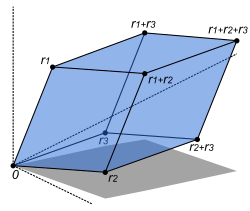Determinant
The determinant of a square matrix is a scalar (a number) that indicates how that matrix behaves. It can be calculated from the numbers in the matrix.
The determinant of the matrix [math]\displaystyle{ A }[/math] is written as [math]\displaystyle{ \det(A) }[/math] or [math]\displaystyle{ |A| }[/math] in a formula.[1][2] Sometimes, instead of [math]\displaystyle{ \det\left(\begin{bmatrix}a&b\\c&d\end{bmatrix}\right) }[/math] and [math]\displaystyle{ \left|\begin{bmatrix}a&b\\c&d\end{bmatrix}\right| }[/math], one simply writes [math]\displaystyle{ \det\begin{bmatrix}a&b\\c&d\end{bmatrix} }[/math] and [math]\displaystyle{ \left|\begin{matrix}a&b\\c&d\end{matrix}\right| }[/math].
Interpretation
There are a few ways to understand what the determinant says about a matrix.
Geometric interpretation
An [math]\displaystyle{ n \times n }[/math] matrix can be seen as describing a linear map in [math]\displaystyle{ n }[/math] dimensions. In which case, the determinant indicates the factor by which this matrix scales (grows or shrinks) a region of [math]\displaystyle{ n }[/math]-dimensional space.
For example, a [math]\displaystyle{ 2 \times 2 }[/math] matrix [math]\displaystyle{ A }[/math], seen as a linear map, will turn a square in 2-dimensional space into a parallelogram. That parallellogram's area will be [math]\displaystyle{ \det(A) }[/math] times as big as the square's area.
In the same way, a [math]\displaystyle{ 3 \times 3 }[/math] matrix [math]\displaystyle{ B }[/math], seen as a linear map, will turn a cube in 3-dimensional space into a parallelepiped. That parallelepiped's volume will be [math]\displaystyle{ \det(B) }[/math] times as big as the cube's volume.
The determinant can be negative or zero. A linear map can stretch and scale a volume, but it can also reflect it over an axis. Whenever this happens, the sign of the determinant changes from positive to negative, or from negative to positive. A negative determinant means that the volume was mirrored over an odd number of axes.
"System of equations" interpretation
One can think of a matrix as describing a system of linear equations. That system has a unique non-trivial solution exactly when the determinant is not 0[2] (non-trivial meaning that the solution is not just all zeros).
If the determinant is zero, then there is either no unique non-trivial solution, or there are infinitely many.
Singular matrices
A matrix has an inverse matrix exactly when the determinant is not 0. For this reason, a matrix with a non-zero determinant is called invertible. If the determinant is 0, then the matrix is called non-invertible or singular.[2]
Geometrically, one can think of a singular matrix as "flattening" the parallelepiped into a parallelogram, or a parallelogram into a line. Then the volume or area is 0, which means that there is no linear map that will bring the old shape back.
Calculating a determinant
There are a few ways to calculate a determinant.
Formulas for small matrices
- For [math]\displaystyle{ 1 \times 1 }[/math] and [math]\displaystyle{ 2 \times 2 }[/math] matrices, the following simple formulas hold:[2]
- [math]\displaystyle{ \det\begin{bmatrix}a\end{bmatrix} = a,\qquad\det\begin{bmatrix}a&b\\c&d\end{bmatrix} = ad-bc. }[/math]
- For [math]\displaystyle{ 3 \times 3 }[/math] matrices, the formula is:[3]
- [math]\displaystyle{ {\det\begin{bmatrix}a&b&c\\d&e&f\\g&h&i\end{bmatrix} = {\color{blue}{aei}+{dhc}+{gbf}}{\color{OrangeRed}{}-{gec}-{ahf}-{dbi}}} }[/math]
- One can use the Rule of Sarrus (see image) to remember this formula.
Cofactor expansion
For larger matrices, the determinant is harder to calculate. One way to do it is called cofactor expansion.
Suppose that we have an [math]\displaystyle{ n \times n }[/math] matrix [math]\displaystyle{ A }[/math]. First, we choose any row or column of the matrix. For each number [math]\displaystyle{ a_{ij} }[/math] in that row or column, we calculate something called its cofactor [math]\displaystyle{ C_{ij} }[/math]. Then [math]\displaystyle{ \det(A) = \sum a_{ij} C_{ij} }[/math].[2]
To compute such a cofactor [math]\displaystyle{ C_{ij} }[/math], we erase row [math]\displaystyle{ i }[/math] and column [math]\displaystyle{ j }[/math] from the matrix [math]\displaystyle{ A }[/math]. This gives us a smaller [math]\displaystyle{ (n-1)\times(n-1) }[/math] matrix. We call it [math]\displaystyle{ M }[/math]. The cofactor [math]\displaystyle{ C_{ij} }[/math] then equals [math]\displaystyle{ (-1)^{i+j} \det(M) }[/math].
Here is an example of a cofactor expansion of the left column of a [math]\displaystyle{ 3 \times 3 }[/math] matrix:
[math]\displaystyle{ \begin{align} \det \begin{bmatrix}{\color{red}1}&3&2\\{\color{red}2}&1&1\\{\color{red}0}&3&4\end{bmatrix} &= {\color{red}1} \cdot C_{11} + {\color{red}2} \cdot C_{21} + {\color{red}0} \cdot C_{31} \\ &= \left( {\color{red}1} \cdot (-1)^{1+1} \det\begin{bmatrix}1&1\\3&4\end{bmatrix} \right) + \left( {\color{red}2} \cdot (-1)^{2+1} \det\begin{bmatrix}3&2\\3&4\end{bmatrix} \right) + \left( {\color{red}0} \cdot (-1)^{3+1} \det\begin{bmatrix}3&2\\1&1\end{bmatrix} \right) \\ &= ({\color{red}1} \cdot 1 \cdot 1) + ({\color{red}2} \cdot (-1) \cdot 6) + {\color{red}0} \\ &= -11. \end{align} }[/math]
As illustrated above, one can simplify the computation of determinant by choosing a row or column that has many zeros; if [math]\displaystyle{ a_{ij} }[/math] is 0, then one can skip calculating [math]\displaystyle{ C_{ij} }[/math] altogether.
Determinant Media
The volume of this parallelepiped is the absolute value of the determinant of the matrix formed by the columns constructed from the vectors r1, r2, and r3.
Related pages
References
- ↑ "Comprehensive List of Algebra Symbols". Math Vault. 2020-03-25. Retrieved 2020-09-09.
- ↑ 2.0 2.1 2.2 2.3 2.4 Weisstein, Eric W. "Determinant". mathworld.wolfram.com. Retrieved 2020-09-09.
- ↑ "Determinant of a Matrix". www.mathsisfun.com. Retrieved 2020-09-09.





